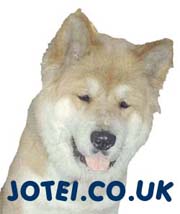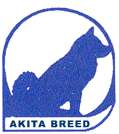FCI Japanese Akita Breed Standard
ORIGIN:Japan
UTILIZATION: Companion Dog
CLASSIFICATION FCI: Group 5 (Spitz and primitive type.)
Section 5 (Asian Spitz and related breeds.) Without Working trial.
BRIEF HISTORICAL SUMMARY:
Originally Japanese dogs were small to medium in size and no
large breeds existed. Originating in the Tohoku Area, as a hunting dog of medium size as an Akita Matagi (bearhunting dog), around 1630-1870 under the Satake Clan in the Akita region. Breeding of the breed to promote dog fights was encouraged in order to raise the moral of the land barons in the region, according to remaining historical records. Subsequently the breed was cross bred with the dog thought to be a Mastiff owned by a German mining engineer at the Kosake copper mines and with a Tosa fighting dog (cross bred from the medium sized Japanese breed Shikoka Mastiff crossed with German Pointers, St. Bernards and Great Danes, etc); the heretofore known identity of pointed ears and ringtails which were originally characteristic of Akitas was lost. In 1908 dog fighting became prohibited and public opinion gradually favoured preserving this breed among professors and learned people. In 1919 the law for preservation of
natural monuments was established, and as a result of fanciers’ effort to improve the breed thereafter, in 1931 nine superior dogs of this breed were designated as natural monuments, and the breed became widely popular. At the end of the 2nd World War in 1945, efforts were made to eliminate the strain of the Mastiffs and other foreign breeds from the few remaining Akitas to establish a pure Akita and succeeded in stabilizing the pure strain of large Akitas known today.
GENERAL APPEARANCE:
Large-sized dog, sturdily built, well balanced and with much substance; secondary sex characteristics strongly marked, with high nobility and dignity in modesty; constitution tough.
IMPORTANT PROPORTIONS:
The ratio of height at withers to length of body (from the point of the shoulders to the point of the buttock) is 10:11, but the body is slightly longer in bitches than in dogs.
BEHAVIOUR AND TEMPERAMENT:
The temperament is composed, faithful, docile and receptive.
HEAD
CRANIAL REGION:
Skull: The size is in proportion to the body. The forehead is broad with distinct furrow. No wrinkle.
Stop: Defined.
FACIAL REGION:
Nose: Large and black. In case of white coat, flesh colour permitted.
Muzzle: Moderately long and strong with broad base, tapering but not pointed. Nasal bridge straight.
Jaws/Teeth: Teeth strong with scissor bite.
Lips: Tight
Cheeks: Moderately developed.
Eyes: Relatively small, almost triangular in shape due to the rising of the outer eye corner, set moderately apart, dark brown: the darker the better.
Ears: Relatively small, thick, triangular, slightly rounded at tips, set moderately apart, pricked and inclining forward.
NECK:
Thick and muscular, without dewlap, in balance with head.
BODY:
Back: Straight and strong.
Loin: Broad and muscular.
Chest: deep, forechest well developed, ribs moderately well sprung.
Belly: Well drawn up.
TAIL: Set on high, thick, carried vigorously curled over back; the tip nearly reaching the hocks when let down.
LIMBS:
FOREQUARTERS:
Shoulders: moderately sloping and developed.
Elbows: Tight
Forearms: Straight and heavy boned.
HINDQUARTERS: Hindlegs well developed, strong and moderately angulated.
FEET: Thick, round arched and tight.
GAIT: Resilient and powerful movement.
COAT
HAIR: Outer coat harsh and straight, undercoat soft and dense; the withers and the rump are covered with slightly longer hair; the hair on tail is longer than on the rest of the body.
COLOUR: Red fawn, sesame (red fawn hairs with black tips) brindle and white. All the above mentioned colours except white must have a urajiro (urajiro = whitish coat on the sides of the muzzle, on the cheeks, on the underside of jaw, neck, chest, body and tail and on the inside of the legs).
SIZE: Height at the withers: Dogs 67 cm. Bitches 61 cm There is a tolerance of 3 cm more or less.
Faults: Any departure from the foregoing points should be considered a fault and the seriousness with which the fault should be regarded should be in exact proportion to its degree.
Bitch dogs/doggy bitches.
Undershot or overshot mouth.
Missing teeth.
Spotted tongue.
Iris light in colour.
Short tail.
Black mask.
Markings on white background.
Shyness.
DISQUALIFYING FAULTS:
Ears not pricked.
Hanging tail.
Long hair (shaggy).
|







